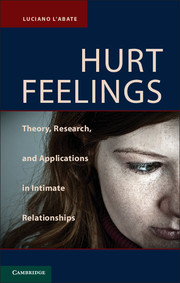Book contents
- Frontmatter
- Contents
- Preface
- Acknowledgments
- Introduction
- Part One Background
- 2 Hurts
- 3 The Origins of Hurt Feelings
- 4 The Developmental Socialization of Hurt Feelings
- 5 Hurt Feelings in the Family
- Part Two The Scientific Bases of Hurt Feelings
- Part Three Applications of Hurt Feelings in Mental Health
- Part Four Models of Hurt Feelings In Theory and Applications
- Appendix A An Informed Consent Form to Deal with Hurt Feelings
- Appendix B Experimental Scale of Unexpressed Hurt Feelings
- References
- Author Index
- Subject Index
5 - Hurt Feelings in the Family
from Part One - Background
Published online by Cambridge University Press: 05 June 2012
- Frontmatter
- Contents
- Preface
- Acknowledgments
- Introduction
- Part One Background
- 2 Hurts
- 3 The Origins of Hurt Feelings
- 4 The Developmental Socialization of Hurt Feelings
- 5 Hurt Feelings in the Family
- Part Two The Scientific Bases of Hurt Feelings
- Part Three Applications of Hurt Feelings in Mental Health
- Part Four Models of Hurt Feelings In Theory and Applications
- Appendix A An Informed Consent Form to Deal with Hurt Feelings
- Appendix B Experimental Scale of Unexpressed Hurt Feelings
- References
- Author Index
- Subject Index
Summary
Although the family is a central, enduring, and taken-for-granted social institution, it is also one of the most variable, contested, debated, and analyzed by scholars, policy-makers, special interest groups, and family members alike. Bielby, 1999 (p. 391)
The concept of family qua family, dear to most researchers and theorists, no longer exists as conceived in the past. As Hofferth and Casper (2007) demonstrated, only one-fourth of all domiciles in United States qualify as families, defined traditionally by two legally married adults with children born from that particular bond. Three-fourths of most domiciles today include unmarried singles, single mothers or fathers with children, married couples with no children, remarried couples with children from two previous marriages, same-sex couples with no children or with children from previous marriages, grandparents raising grandchildren, cohabiting couples, or single parents living with another partner and not remarried, among many other possibilities.
That is why, given such a tenuous standing in the scholarly community, the construct of intimate relationships was chosen instead, as characterized by closeness, commitment, interdependence, and duration (Burleson, 1995; L’Abate, 2005). These characteristics are found more often in friends than in some families (Fehr & Harasymchuk, 2009). The term family will be used here provisionally, with an understanding of its relative and limited nature: people living under the same roof linked by emotional, financial, legal, practical, and friendship bonds that go beyond what has existed in the past. The family, caretakers, partners, or friends are the gymnasia where we learn how to experience and express feelings in general and hurt feelings in particular (Cummings, Davies, & Campbell, 2000; Jacob, 1987; Kaslow, 1996; L’Abate, 1997).
- Type
- Chapter
- Information
- Hurt FeelingsTheory, Research, and Applications in Intimate Relationships, pp. 106 - 126Publisher: Cambridge University PressPrint publication year: 2011



